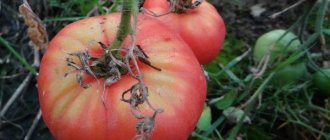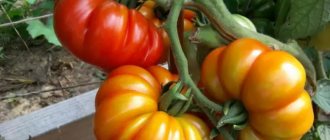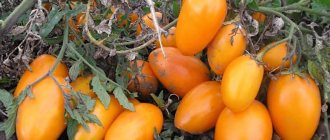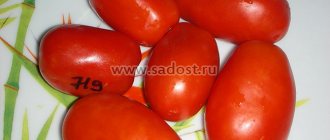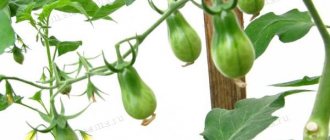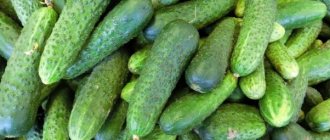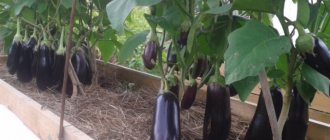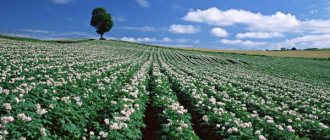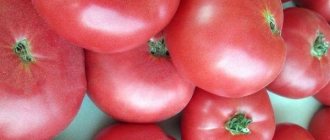Gardening » Pear
0
1065
Article rating
Kira Stoletova
Firefly pear rightfully takes its place among the most popular fruit trees in the CIS. The hybrid variety was bred by Russian breeders and approved for use in the Central region since 2002.
Characteristics of the Svetlyanka pear variety
Description of the variety
Pear is included in the group of varieties with early autumn ripening. Since 2002, the variety has been included in the State Register and recommended for cultivation in the Central region of Russia.
Characteristics of wood
The tree is medium-sized and reaches a height of 6-7 meters. The crown is wide, spreading, medium dense, and has a pyramidal shape. The shoots are covered with light brown bark. The leaves are medium in size, green, and oval in shape. The surface of the leaf plate is smooth.
Description of fruits
Firefly pear fruits.
Pears are small and the average weight of one fruit is 90-120 grams. The shape of the fruit is round. The main color of the pear is yellow-green. During ripening it turns golden yellow. On the sunny side, a faint, blurred blush of a reddish tint appears.
The taste of the fruit is sweet and sour, semi-oily, with a weak aroma. The pulp is very tender and juicy.
Fruit maturity occurs in mid-September. The harvested crop can be stored in the refrigerator for about 3 months.
Early autumn pear Firefly 1.7m. three-year-old ZKS in a container
Delivery to your door. Guaranteed survival rate of seedlings for 1 year!
Early autumn variety. The originator is the State Scientific Institution All-Russian Research Institute of Genetics and Selection of Fruit Plants named after. I. V. Michurina. Authors of the variety: P. N. Yakovlev, S. P. Yakovlev, A. P. Gribanovsky. Obtained from crossing a hybrid seedling (Ussuri Ch Bere Ligelya) with the Lyubimitsa Klappa variety. Zoned in the Central region since 2002.
The tree is medium-sized, with a pyramidal, spreading crown of medium density. Mixed fruiting type.
The shoots are medium thick, straight, light brown, glabrous, with many lentils. The buds are small, bent, conical, smooth. The leaves are medium-sized, oval, short-pointed, with a helical twisted tip, green, smooth, the leaf blade is curved upward, the serration is finely serrated. The petiole is medium long, thin, glabrous.
The fruits are below average and medium size, weighing 90-120 g, round, smooth, regular in shape. The skin is medium, smooth, oily, with a waxy coating. The main color at the time of removable maturity is greenish-yellow, during the period of consumer maturity it is golden-yellow; the cover is red over the smaller part of the fruit, blurred. The peduncle is medium, oblique. The funnel is deep, medium, rustiness is weak, the cup is half-open and does not fall off, the saucer is deep, medium. The heart is medium, round, the seed chambers are closed, medium. The seeds are medium-sized, elongated, black. The pulp is creamy, medium density, tender, semi-oily, juicy without granulation, the taste is sweet and sour with a faint aroma. Tasting score 4.5 points. The fruits contain dry soluble substances - 15.4%, sugars - 13.7%, titratable acids - 0.4%, ascorbic acid - 11.4 mg/100g, P-active substances - 122.0 mg/100g. Harvesting maturity occurs in the first ten days of September; the duration of the consumption period in refrigerated storage conditions is 90 days. The fruiting period begins at 6-7 years. Productivity is high. It is characterized by sufficient winter hardiness and high disease resistance.
Advantages of the variety: good taste of fruits, complex resistance to diseases, when using fruits for processing, high-quality products are obtained.
Disadvantages of the variety: when the crown thickens, the fruits become smaller; during long-term storage, superficial rotting of some of the fruits is sometimes observed.
Delivery to your door. Guaranteed survival rate of seedlings for 1 year!
Reviews
Vladislav
Priovrazhnoye
The pear has grown quite tall, with a spreading crown, so this variety is definitely not suitable for a small garden plot. The tree itself does not require special care and very rarely gets sick. However, I was upset that I waited 7 whole years for the first harvest from it.
Catherine
Kazan
The tree produces very good and high-quality harvests. Pears have an excellent taste, ripen fairly quickly and are stored for a long time. The collected fruits are enough for making jam and for storing in the cellar.
Natalia
Bryansk
The pears are not very big, but they taste amazing. It’s great that they can be stored for several months, because eating them fresh is a pleasure. Closer to the New Year, we process everything that we didn’t have time to eat and get excellent jam.
Modern assortment of pears
The State Register of Breeding Achievements approved for use in the Russian Federation in 2021 included 150 pear varieties (Table 1).
Of these, the following varieties have the widest access to production (in 4 - 6 regions): Severyanka, Lada, Mramornaya. On the territory of 3 regions, 13 varieties are zoned: Dessertnaya Rossoshanskaya, Lel, Lyubimitsa Klappa, Lyubimitsa Yakovleva, Moskvichka, Nevelichka, Otradnenskaya, Pamyati Yakovleva, Povislaya, Rossoshanskaya beautiful, Svarog, Uralochka, Chizhovskaya. The overwhelming number of varieties (76%) are approved for use in only one region. The largest number of pear varieties (29 - 48) are recommended for cultivation in the VI (North-Caucasian), III (Central) and V (Central Black Earth) regions, 5 - 18 varieties each in II (North-Western), IV - ( Volga-Vyatka), VIII (Lower Volga), IX (Ural), VII (Middle Volga), XII (Far Eastern), XI (East Siberian) X (West Siberian) regions of Russia. There is no zoned assortment of pears in the Northern region of our country.
Table 1. Pear varieties included in the State Register of Breeding Achievements of the Russian Federation, 2021
| Variety | Region of admission |
| Afabet | 6 |
| Augustinka | 8 |
| August dew | 5 |
| Alyonushka | 5 |
| Allegro | 5 |
| ® Banana | 3 |
| Bashkir summer | 4, 9 |
| Bashkir autumn | 9 |
| Belarusian late | 2, 3 |
| Bergamot Dagestan | 6 |
| Bere bosk | 6 |
| Bere winter Michurina | 5, 8 |
| Bere Moskovskaya | 3 |
| Bere Nalchik | 6 |
| ® Careful | 4 |
| Bryansk beauty | 3 |
| Vassa | 6 |
| Century-old | 4 |
| ® Veles | 3 |
| Verbena | 6 |
| ® Faithful | 3 |
| Veselinka | 10, 11 |
| ® Vidnaya | 3 |
| Victoria | 6 |
| Williams | 6 |
| Williams Rouge Delbara | 6 |
| Vitchiznyana | 6 |
| Granddaughter | 10, 12 |
| Harmony | 6 |
| Guards winter | 6 |
| ® Guidon | 4 |
| Hera | 5 |
| Gimrinskaya | 6 |
| Dagestan summer | 6 |
| Debutanka | 7 |
| Devo | 6 |
| Decabrinka | 9 |
| Dessert | 6 |
| Dessert Rossoshanskaya | 3, 5, 6 |
| ® Children's | 3 |
| Dobryanka | 4 |
| Long-awaited | 10 |
| Dubovskaya early | 8 |
| ® Thumbelina | 3 |
| ® Yeseninskaya | 5 |
| ® Zarechnaya | 4 |
| Winter cube-shaped | 8 |
| Golden | 6 |
| Emerald | 6 |
| The highlight of Crimea | 6 |
| ® Irista | 5 |
| June early | 6 |
| Caucasus | 6 |
| Karataevskaya | 11 |
| Cathedral | 3 |
| Kieffer | 6 |
| Conklok | 6 |
| Conference | 6 |
| Beauty Chernenko | 3 |
| Red-sided | 9 |
| Krasnodar summer | 6 |
| Krasnoyarsk large | 10 |
| Red Caucasus | 6 |
| Krasulya | 9, 10 |
| Kuban late | 6 |
| Kupava | 10 |
| Kuyumskaya | 10, 11 |
| Lada | 2, 3, 5, 7, 11 |
| Lada Amurskaya | 12 |
| Larinskaya | 9 |
| ® Leuven | 6 |
| Lel | 9, 10, 11 |
| Lyra | 3 |
| ® Lyuberskaya | 6 |
| Clapp's Favorite | 2, 6, 8 |
| Yakovlev's favorite | 3, 5, 7 |
| Maria | 6 |
| Mashuk | 6 |
| Myth | 4, 10 |
| Muscovite | 3, 4, 7 |
| Marble | 3, 4, 5, 8 |
| Mriya | 6 |
| Muratovskaya | 5 |
| Hope of the steppe | 6 |
| Nalchik Kostyka | 6 |
| Elegant Efimova | 3,7 |
| Small | 2, 10, 11 |
| ® Nika | 5 |
| Novella | 5 |
| Novosadovskaya | 6 |
| November | 12 |
| November Moldova | 6 |
| Olenek | 10, 11 |
| Original | 6 |
| Oryol beauty | 5 |
| Oryol summer | 5 |
| Autumn Dream | 5 |
| Autumn Susova | 3 |
| Autumn Yakovleva | 5, 8 |
| Otradnenskaya | 2, 5, 11 |
| Palmyra | 12 |
| In memory of Yakovlev | 3, 5, 7 |
| Commemorative | 5 |
| Memory Gosenchenko | 12 |
| Memory of Zhegalov | 3 |
| Parshin's memory | 5 |
| Pervomayskaya | 5 |
| Permyachka | 4 |
| Perun | 10, 11 |
| ® Petrovskaya | 3 |
| Hanging | 9, 10, 11 |
| Simply Maria | 3 |
| Early | 7 |
| Dawn | 6 |
| ® Coeval | 3 |
| Rogneda | 3 |
| Rossoshanskaya is beautiful | 5, 6, 8 |
| Ruddy golden eagle | 8 |
| Rosy Kedrina | 7 |
| Rusakovskaya | 12 |
| Samara beauty | 7 |
| Samaritan woman | 7 |
| Nugget | 6 |
| Swamar | 6 |
| Svarog | 4, 10, 11 |
| Sverdlovsk resident | 8 |
| Firefly | 3 |
| Severyanka | 4, 7, 9, 10, 11, 12 |
| Northern red-cheeked | 5 |
| Selyanka | 5 |
| Siberian | 10, 11 |
| Fabulous | 9 |
| Skorospelka from Michurinsk | 3, 7 |
| Tauride | 6 |
| Talitsa | 4 |
| Tatiana | 6 |
| Subject | 10, 12 |
| Quiet Don | 5 |
| Tyutchevskaya | 5 |
| Uralochka | 4, 10, 11 |
| February souvenir | 5 |
| Extravaganza | 5 |
| Black Sea amber | 6 |
| Chizhovskaya | 2, 3, 7 |
| Miraculous | 5 |
| Elbrus | 6 |
| Yubileinaya Korneeva | 8 |
| ® Yuryevskaya | 3 |
| Apple-shaped | 12 |
| Yakimovskaya | 6 |
| ® Yakovlevskaya | 5 |
The ® symbol marks varieties protected by patents for breeding achievements.
Landing
Proper planting is the basis for the healthy development of the pear in the future. In the selection of articles below, you can find detailed instructions for planting seedlings of the Svetlyanka variety.
How to plant a pear tree correctly
At what distance to plant pears?
How to choose pear seedlings
How to replant a pear
Adviсe
By the way, one of some of the features of the Firefly pear is the tendency for the fruit to decrease if the crown thickens too much, so try to prune it as often as possible.
Also, do not forget to enrich the soil in the place where the Svetlyanka variety grows with organic fertilizers (every three years), and with mineral fertilizers annually, from the second year from the moment of planting.
How to prepare a variety for winter?
Since the variety is resistant to cold, it does not need to be covered in winter.
Care
Firefly pear needs regular pruning and crown shaping. Otherwise, caring for trees of this variety is no different from others. By clicking on the links below, you can find a lot of useful information on this issue.
How to care for a pear Pruning a pear Pruning a columnar pear Treating a pear from diseases and pests Feeding a pear How to water a pear
Planting and care
The best time for planting Firefly pears is autumn , but if you want to plant in the spring , you will need to prepare holes for this in the fall.
These trees will feel best in loose soil, which facilitates access of air and moisture to the roots. It would be great if the soil contained a little clay, which would help retain moisture near the roots of the tree.
Planting holes should be prepared in sunny, but not very hot places in your garden. The depth of the planting hole should be about 40-50 centimeters, and the width should be about 1 meter. It is advisable that the pits be located on the south, west or southwest side.
The soil dug out of the hole must be mixed with organic fertilizers, which can be rotted manure, peat or compost, as well as mineral fertilizers, which include phosphorus and potassium. Lime and wood ash must be added to acidic soil
First you need to make a small mound of soil at the bottom of the hole, and drive a peg into the center. After this, you need to place the seedling in the hole and carefully distribute its roots over the mound. Fill the hole with soil and tamp it down.
Immediately after planting, make an earthen ridge around the tree and pour two buckets of water into it. When it is absorbed, mulch the soil and tie the tree to a stake , without over-tightening it.
The best method of watering for these trees is sprinkling, but you can also pour water into a ditch dug around the trunk circle. For one square meter of tree trunk circle, 3 buckets of water will be enough.
One of the features of the Svetlyanka pear is its tendency to reduce the size of the fruit as the crown thickens, so it is necessary to regularly prune it.
to enrich the soil where the Firefly pear grows with organic fertilizers once every three years, and mineral fertilizers should be applied annually , starting from the second year after planting the trees.
Diseases and pests
The variety is highly resistant to various diseases. In order to completely eliminate the risk of disease, it is necessary to carry out regular preventive measures. Recommendations for plant protection can be found in the articles selected below.
Dangerous Pear Pests
Pears often suffer from pests, they affect the leaves, bark and fruits.
In this article, we have selected 11 of the most harmful insects that harm pear trees, and also ways to destroy them.
Diseases of pear trees
To get what they cherish, gardeners have to work hard, and the reason for this is pear diseases.
Read about 19 common pear diseases and how to combat them.
Pests
- Pear sawfly - its larvae are located in the middle of the ovary, feed on the core, then move on to neighboring fruits. The larva can damage 3-4 fruits, causing them to turn black.
- Fruit mites - feed on tree sap, which leads to disruption of water balance, slowdown of photosynthesis and premature leaf fall.
- Codling moths actively devour the fruits of pear crops and lay eggs on them.
- Hawthorn - destroys all ovaries and flowers, leaving behind only bare branches.
- The common pear borer is a pest that sucks sap from tree leaves, after which they curl and fall off. The trees weaken and bear fruit poorly.
- Moths and aphids are pests that can quickly destroy a pear tree by biting into young shoots and leaves. They can eat the fruits.
Control and prevention measures for this variety include treatment with insecticides, cutting and disposal of damaged tree structures, whitewashing the trunk with fungicides and clearing it of old bark.
